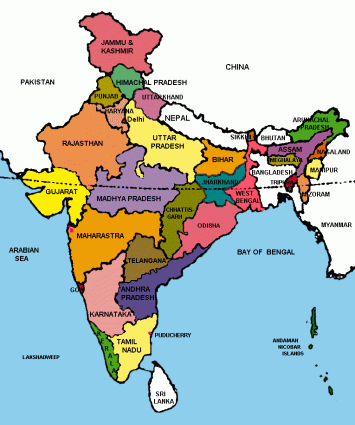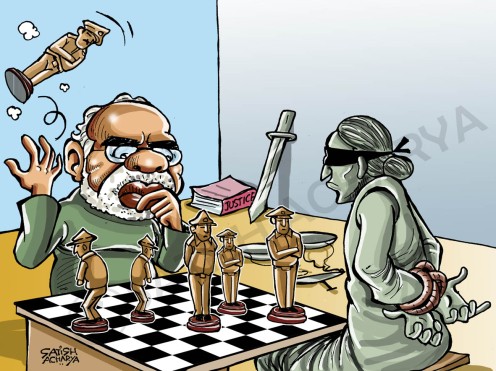Melting Pot
On the 12th of May the voting process in India has finished. Another elections, where 814 mln voters participated comes to an end after 5 weeks and 9 phases of voting. The results will be known on the 16th of May, but according to international analysts the shift in power is coming as the ”biggest democracy in the world” is choosing its lower house, the Lok Sabha with 545 MPs1 . That gives a proportional number in comparison with the European Union Parlament where 400 mln eligible voters soon will elect 751 MEPs (Members of European Parliament).
India’s Voting System
As for the voting system, India has developed a unique combination of procedures. With the population on 1, 237 bln people, and 814 mln eligible voters, the country may struggle with many logistics problems. The country is divided into 29 + 7 territories, that where assigned its ”day of vote” in the five weeks long voting process. Some territories were assigned as many as 6 different dates for voting, this is the case of Uttar Pradesh the most populous Indian state (over 200 mln inhabitants, 130 mln eligible to vote).
The Electoral Commission has prepared a specific ”Model Code of Conduct” to help resolve the most complicated issues2. According to it the parties should not appeal to caste or communal feelings connected with one’s faith, no places of worship shall be used as a place of election propaganda, no candidate shall indulge in any activity that would aggravate existing differences or mutual hatred, meetings and processions should be decided beforehand with local authorities, etc. For the people to cast their vote there were established 930 000 polling stations, the range not exceeding 1,2 km walk for voters. As for all difficulties an Indian voter may face, the average election turnout is high ( in 2009 it reached approx. 60%).
The number of parties that presented for elections reached 142. Nevertheless the political scene is overwhelmingly dominated by two biggest parties: the (still) ruling Indian National Congress (INC) and the Bharatiya Janata Party ( BJP). Bearing in mind the illiteracy dimensions in the country, both parties are represented by different symbols: INC – the hand, BJP – the lotus flower. Of course both parties are taking advantage of the illiterate population, sticking to the caste division and at the same time willing to gain their votes.
The Shift in Power
The ruling INC party that has been ruling in India for 10 years is expected to lose this year. Manmohan Singh, the Prime Minister is being accused by the opposition parties of adopting neoliberal policies that slowed down India’s growth (4,4% in 2013 vs. 10% in 2009) and of growing corruptrion within the government ( frauding telecommunication companies, concession of illegal mine exploitation permissions, etc). As Naïké Desquesnes hits the point, ”without charisma, the candidate of INC for the prime minister’s seat, Rahul Ghandi (the grandson of Jawaharal Nehru) does not convince anyone”3. The INC party recalling its most famous political leaders Jawaharal Nehru or the Ghandi family is trying to convince people of its right to rule…Well, its been doing it since the independence in 1947. However, implementing the solutions that worked during Nehru mandate is extremely difficult in a fast-changing world. The corruption scandals, growing hatred among hindu and muslim populations and the exhausted economy seem to be calling for harsher solutions.
That is the time where BJP party appears. The Indian People’s Party created in 1980, has been progressively challenging the Indian political scene. The party that mixes political and religious issues, places itself in the right-wing Hindu nationalism. The BJP party appeals for the full incorporation of disputed Kashmir region to India, strong nuclear deterrence and a strong India in the region. The policies of BJP can be easily traced as in 1998 a National Democratic Alliance (NDA) where BJP was included ruled the country. The Kargil War of 1999 between India and Pakistan in the Kashmir region (after a pakistani inflitration into the military and political structures on the Indian side of Kashmir). The Guyarat region violence of 2002 aimed against the muslim population which shadows are still present in this coastal region. Or antiterrorist acts passed by the NDA government giving sometimes unlimited power to the security forces.
And its the Guyarat that represents the ”microcosm” of what may happen in India. The homeland of Mahatma Gandhi (Porbandar, 1869) and the origin of the Salt March which brought independence to India4. It is also the place where segregation between muslim and hindu population is growing and turning out to be very turbulent and violent. The Chief Minister of the Guyarat, Narendra Modi, is the Prime-ministerial candidate of the BJP. On the 27th of February 2002, the fire that broke out on the train connecting Uttar Pradesh with Guyarat. 58 hindu passangers died, the muslim living in the region next to the accident were accused of arsony. The violence against muslims that followed caused at least 2000 muslim deaths. 200 000 muslims were deprived of their homes and 400 women violated. Modi did not stop the violence and its discourse took strong anti-muslim resonance. This turned him into the heroe of hindu nationalis movement.
On the 16th of May official results of the elections will be given, but the exit polls show that the BJP party may take the majority of the seats in 545 Parliament. Will the Guyarat region reflect future policies of India?
Ulka Skwarek
1www.india.gov.in
2Election Commission of India http://ceolakshadweep.gov.in/pdf/MCC/mcc.pdf
3Le Monde Diplomatique Español ”La esperanza del ‘hombre común” N. Desuquesnes, Mayo 2014 p. 15
4Robert Kaplan, Monsoon p. 137-148




